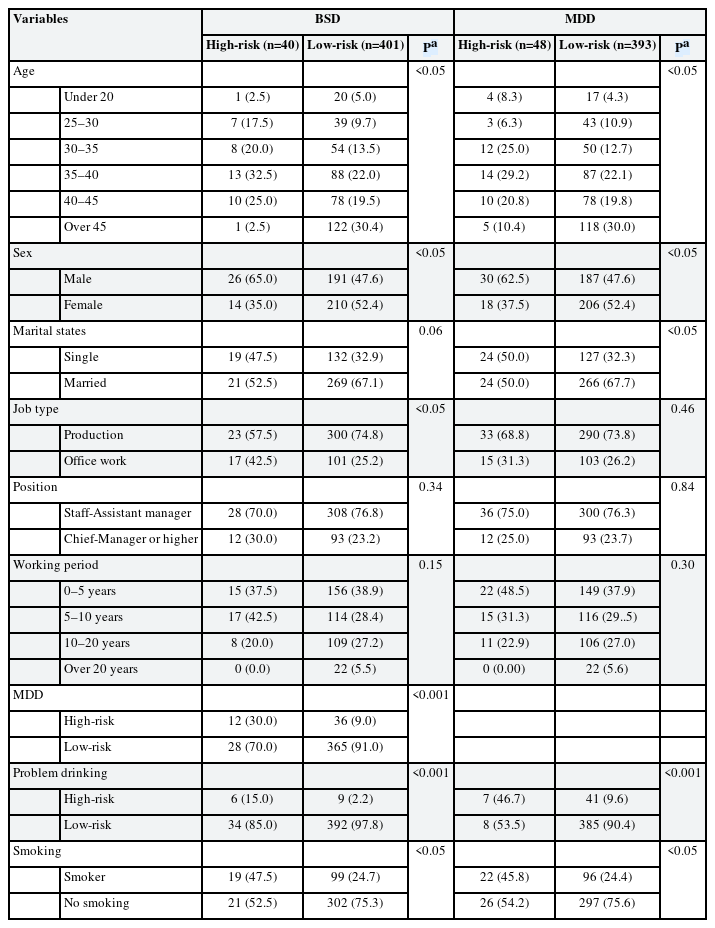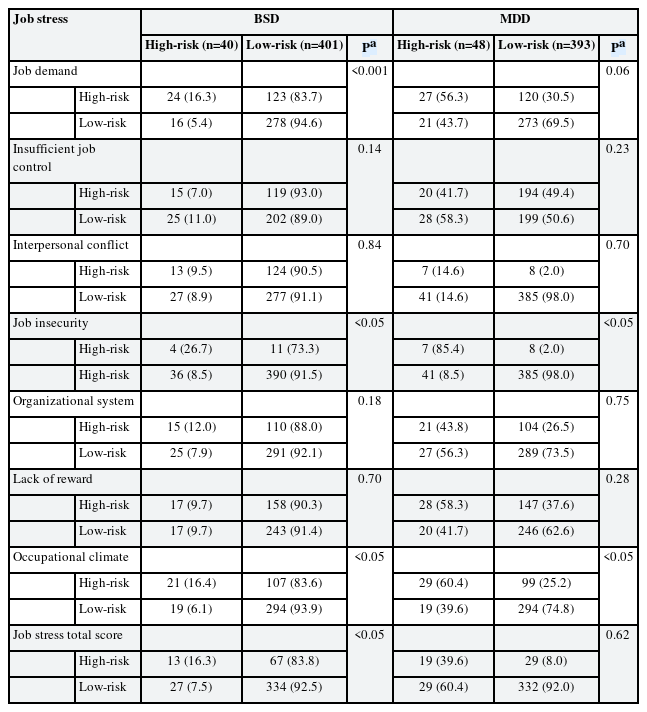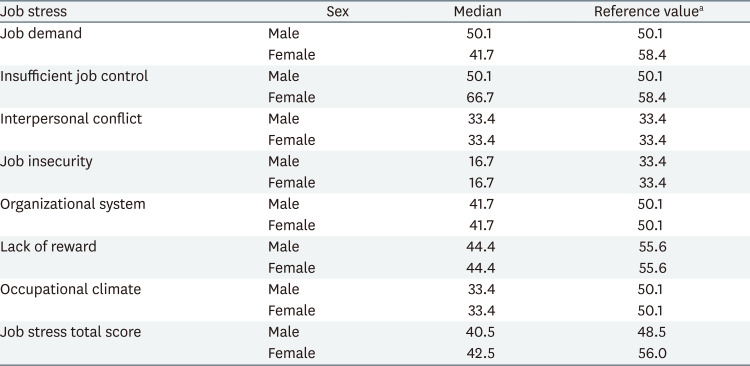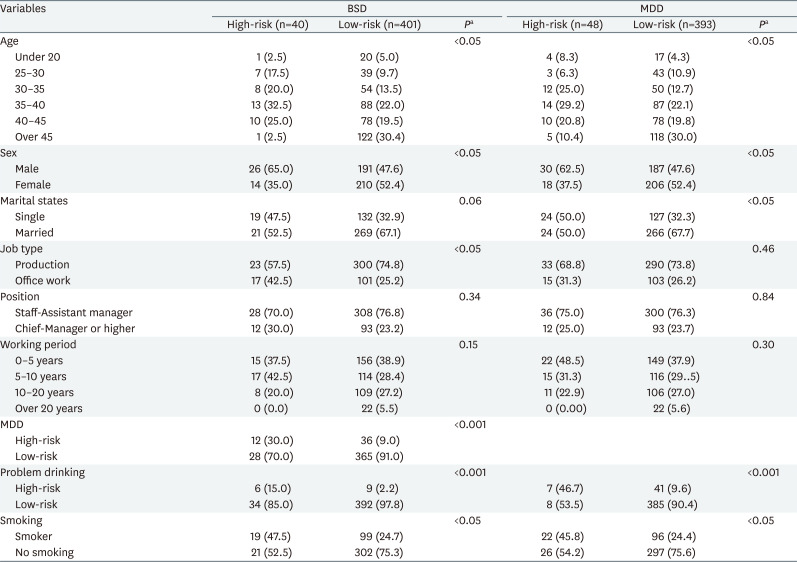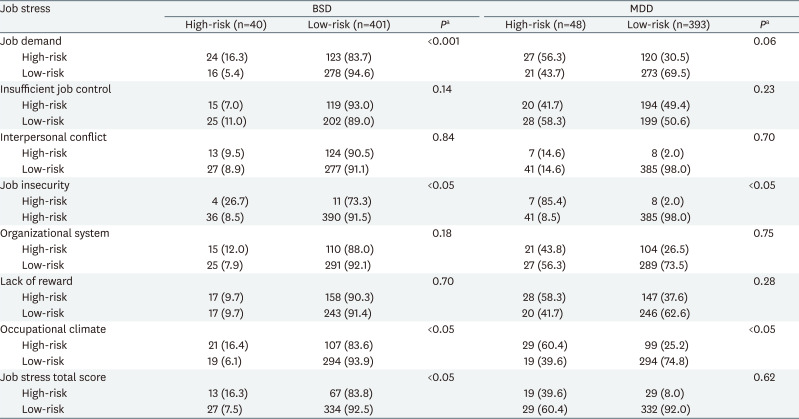Effects of job stress on symptoms of bipolar spectrum disorder in an electronic parts manufacturing company
Article information
Abstract
Background
Mental illness is known to be caused by genetic, biological, and environmental risk factors. Although previous studies have established the link between mental illness and job stress, most of them are limited to major depression disorder. Therefore, this study examined the relationship between job stress and bipolar spectrum disorder (BSD).
Methods
This is a cross-sectional study based on a survey conducted in April 2017 at an electronic parts manufacturing company in Busan. In a total of 441 workers, the degree of BSD was identified using the Korean version of the Mood Disorder Questionnaire, and the degree of job stress was identified using the Korean Occupational Stress Scale Short Form. This study also identified general characteristics of workers and job-related factors. The χ2 test and Fisher's exact test was conducted to determine the differences among the variables, based on BSD. Multiple logistic regression analysis was conducted to determine the influence of independent variables on BSD.
Results
Cross-analysis showed significant differences between the BSD high-risk and low-risk groups regarding age, sex, occupation, smoking, problem drinking, job stress total score, occupational climate, and major depression disorder symptom. In addition, the significant differences between the BSD high-risk and low-risk groups about job stress were observed in terms of job demand, job insecurity, and occupational climate. A multiple logistic regression analysis revealed that the high-risk group in the job stress group had a higher effect on BSD than the low-risk group (odds ratio [OR]: 2.32, 95% confidence interval [CI]: 1.10–4.88). Among the categories of job stress, high-risk groups in 3 areas—job demand (OR: 2.56, 95% CI: 1.27–5.17), job insecurity (OR: 4.42, 95% CI: 1.19–16.42), and occupational climate (OR: 2.55, 95% CI: 1.29–5.05)—were more likely to have an impact on BSD than the low-risk groups.
Conclusions
This study demonstrated that the high-risk groups of job stress total score, job demand, job insecurity, and occupational climate had a more significant effect on BSD than the low-risk groups. As workers with BSD may have difficulties in their work and personal lives, there is a need to manage job stress to prevention of BSD.
BACKGROUND
The causes of mental illness are known to be genetic, biological, and environmental. The genetic risk factors include a family history of mental illness, 22q11.2 deficit, single nucleotide variant, and copy number variation. The biological risk factors include maternal infection, obstetric problems, malnutrition, brain damage, structural and functional changes caused by serotonin and glucocorticoid in the brain, hormonal changes, and substance abuse. The environmental risk factors include bullying, abuse, lack of adequate stimulation, socio-economic inequality, stress, immigration, social isolation. In particular, environmental risk factors are thought to create synergies with genetic and biological risk factors, causing mental illness [1]. Bipolar spectrum disorder (BSD), like other mental illnesses, is assumed to be caused by environmental factors [2]. Previous studies have reported the association between BSD and environmental risk factors such as stress [34].
Bipolar disorder is a psychiatric disorder that involves alternating between periods of mood swings at both extremes of mania or depression and periods of normal mood. Bipolar disorders are often referred to in academic terms as manic depressive illnesses and are classified as Type I, Type II, subthreshold bipolar disorder, or BSD. This concept covers all bipolar disorders. A study by Merikangas et al. [5] reported that the global 1-year prevalence of BSD was 1.5%, and the lifetime prevalence was 2.4%.
The occurrence of BSD is generally known to involve 3 mechanisms. These are hypothalamus-pituitary-adrenal (HPA) axis hyperactivation, monoamine dysregulation, and circadian rhythm dysregulation [6]. Previous studies have shown that early life stress can alter the HPA axis in later life [6]. Murri et al. [7] reported that stress may increase the likelihood of BSD and other diseases by causing hyperactivity of the adult HPA axis. Muneer [8] suggested that long-lasting life stress induces hyperactivity of the HPA axis and the generation of reactive oxygen species in the nerves. This leads to neurotoxic kynurenine metabolites, resulting in the dysregulation of the circadian molecular clock and BSD manic episodes [8]. Monoamine dysregulation is also known to be associated with stress. In general, monoamine dysregulation is expressed as a result of stress in mood disorders. Unlike some cases of depression, BSD is expressed for other unknown reasons [9]. Some researchers explain that the development of BSD prevents human beings from becoming depressed through a mechanism called “manic defenses” [10]. Others explain that circadian rhythm dysregulation will act as a “switch,” causing BSD [11].
Previous studies have centered their research on Karasek's (1979) demand-control model and Siegrist's (1996) effort-reward imbalance model [1213]. In particular, there are a number of studies on job stress and major depressive disorder (MDD) based on these models [14151617].
In Korea, previous research on the relationship between job stress, musculoskeletal disorders, and mental disorder symptoms was conducted by Jung et al. [18]. Most of the previous studies, however, focused on the relationship between depression and job stress. Although the relationship between BSD and job stress has not been confirmed, the authors of the study found literature on the same. Therefore, further research on the effect of job stress on BSD is needed. In this study, job stress was measured based on the Korean Occupational Stress Scale Short Form (KOSS-SF). After determining the degree of BSD through the Korean version of the Mood Disorder Questionnaire (K-MDQ), we investigated the correlation between BSD and other variables. We conducted a comprehensive evaluation of the impact of different variables and job stress on BSD. In addition, the Korean version of the Patient Health Questionnaire-9 (KPHQ-9) was used to assess the degree of depression and to further evaluate the correlation between job stress and depression.
METHODS
Subjects
This study was conducted in April 2017 through a questionnaire in an electronic parts manufacturing company based in Busan. The data were collected by the company. All workers in the company were invited to participate in the study. Excluding 19 workers who gave incomplete answers, a total of 441 workers (217 male and 224 female) were included in the study.
Study procedure
To obtain information on the characteristics of workers such as their sex, marital status, and age, workers were asked to complete the questionnaire. They were then classified as production or office workers according to their job type. In addition, according to the designation of workers in the workplace, their differences were described. The Cut-Annoyed-Guilty-Eye Questionnaire and smoking questionnaire were used to examine the drinking and smoking habits of workers [19]. The KOSS-SF was used to measure the degree and type of workers' job stress [202122].
The K-MDQ was used to measure the degree of BSD. In the case of the K-MDQ, the cutoff value was set to the total score (over 7 points) of symptoms, which is the most appropriate value for sensitivity and specificity [23]. In this study, we applied only the total score criteria of symptoms suggested in previous studies. K-MDQ defined BSD high-risk groups above the BSD cutoff value. The KPHQ-9 was used to analyze the effect of job stress on MDD. A cutoff value based on the scores presented in a previous study was used [24].
Statistical analysis
Data were analyzed using SPSS version 22.0 (Chicago, IL, USA). First, descriptive statistics and analyses were performed. The χ2 test and Fisher's exact test were conducted to identify the general characteristics of male and female workers. Other variables were classified according to sex, and personal characteristics such as job stress, BSD, and marriage, and job-related characteristics such as job type and job position. In addition, the χ2 test and Fisher's exact test was conducted to determine the differences among the variables, based on BSD and MDD. There are no scientific studies indicating drinking alcohol and smoking as a direct cause of increased risk of BSD and MDD development. Therefore, the problem drinking and smoking variables were inappropriate as confounders and were excluded as they could cause collider bias.
A multiple logistic regression analysis was conducted to determine the influence of independent variables on BSD. In the demographic data, BSD was found to have a statistically significant relationship with age, sex, and occupation. The variables of age and sex influenced BSD [2526], and they were used as independent variables. In MDD, statistical significance was confirmed in the age, sex, and marital status variables. In addition, the age and sex variables are generally known to be related to MDD, so the age, sex, and marital status variables were used in a multiple logistic regression analysis [272829]. The statistical significance level was set at P<0.05.
RESULTS
General characteristics
The variables indicating significant differences between men and women were job position, BSD, job demand, insufficient job control, and job insecurity. Among the participants, 211 (47.8%) were 40 years old or older. Among the female workers, 88 (40.6%) were over 45 years old. There were 323 production workers (73.2%): 126 (58.1%) male and 197 (87.9%) female. The number of BSD high-risk workers were 40 (9.1%). In the male group, the high-risk group of BSD included 26 individuals (12.0%), and in the female group, it included 14 individuals (6.3%) (Table 1).
Distributions of job stress factors
In the KOSS-SF, there were differences in job stress among men and women. For male workers, the areas with median values above of Korean workers were “job demand,” and “insufficient job control,” and for female workers, it was “insufficient job control” (Table 2).
Comparisons of BSD and MDD levels based on general characteristics and job stress
Of the 441 people, a total of 40 high-risk BSD workers were identified through the K-MDQ and a total of 48 high-risk MDD workers were identified through the KPHQ-9. The BSD and the cross-tabulation results showed significant differences in age, sex, job type, problem drinking, smoking, job demand, job insecurity, occupational climate, job stress total score, and MDD. The cross-tabulation results between MDD and other variables showed significant differences in age, sex, marital status, problem drinking, smoking, job insecurity, and occupational climate (Tables 3 and 4).
Multiple logistic regression analysis of BSD and MDD related factors
In the case of BSD, multiple logistic regression analysis showed statistically significant results in 4 areas: job stress total score, job demand, job insecurity, and occupational climate. In the case of MDD, multiple logistic regression analysis showed statistically significant results in MDD in 2 areas: job insecurity and occupational climate (Table 5).
DISCUSSION
In this study, we found 9.1% of workers had BSD symptoms. In the 2016 Mental Disorde Survey conducted in Korea, lifetime prevalence rate and annual prevalence rate of BSD were 0.1% [30]. In the United States, the US National Comfort Survey Replication was carried out in a population of 9,282 people. The one-year prevalence rate was 2.8% and the lifetime prevalence rate was 4.4%, with differences in the prevalence rate compared US population to the domestic population [31]. Kim et al. [32] conducted face-to-face interviews with 3,013 Koreans using the Korean version of the Composite International Diagnostic Interview 2.1 and the K-MDQ. The results of the study showed that the lifetime prevalence of BSD was 4.3% (95% CI: 2.6–6.9), which is similar to Koreans' lifetime prevalence of BSD, 4.4%. Considering these results, it is believed that the BSD prevalence rate of 0.1% in the domestic psychological status epidemiology survey may have been underestimated when compared with the prevalence rates in other part of the world [32]. However, the difference in the prevalence of BSD in previous studies may have occurred because of the different clinical diagnosis results and studies due to the different screening tests. However, in this study, the K-MDQ excluded the second and third of the 3 criteria because the sensitivity was too low when all the 3 criteria were satisfied, which may overestimate the actual prevalence [23]. Therefore, this study is about BSD symptoms, not BSD diagnosis.
In the cross-tabulation analysis between BSD and the variables, job stress, occupation, age, sex, and MDD were found to be associated with BSD.
The high odds ratio of MDD could be because Type 1 or Type 2 may have been mistaken for unipolar depression during the major depression episode. In fact, in many cases, both scales may be significant [33]. The pre-study also suggests that both diseases should not be judged by MDQ and PHQ-9 [34].
While comparing occupational characteristics, office workers were found to have a higher proportion of BSD high-risk groups than production workers (OR: 0.46, 95% CI: 0.23–0.89). Regarding sex, the ratio of male to female was higher than in low-risk groups (OR: 2.04, 95% CI: 1.04–4.03). As mentioned earlier, BSD is known to be caused by a combination of genetic, environmental, and biological risk factors such as age and sex. Although odds ratios were identified in occupation, sex, and age, the results conflicted with those of previous studies [252635]. Additionally, because the ratio of sex and age distribution between office workers and production workers differed in the company's workforce, it was difficult to observe the effects of each variable independently. This result is thought to have occurred due to a combination of the factors. As a result, follow-up studies should adjust several variables to examine each effect.
Problem drinking (OR: 5.14, 95% CI: 2.55–10.39) and smoking (OR: 2.76, 95% CI: 1.43–5.34) were found to be highly associated with BSD. However, there are no scientific studies examining drinking and smoking as a direct cause of the increased risk of developing BSD. As a result, in individuals affected by BSD, the level of alcohol consumption and smoking seems to have increased.
To examine the effect of job stress on BSD, multiple logistic regression was performed. Statistical significance was observed in the 4 areas of job stress; job stress total score (OR: 2.32, 95% CI: 1.10–4.88), job demand (OR: 2.56, 95% CI: 1.27–5.17), job insecurity (OR: 4.42, 95% CI: 1.19–16.42), and occupational climate (OR: 2.55, 95% CI: 1.29–5.05).
In particular, job insecurity (OR: 4.42, 95% CI: 1.19–16.42) was higher than other job stress subcategories. In job insecurity, 15 individuals fell under the high-risk group. We asked the company for information on the status of employment to analyze the causes of the high-risk group's job insecurity. At the time of the survey, the company did not hire any workers with a fixed-term contract. As the survey was anonymous, no further investigation could be conducted.
For similar reasons, further investigation was not possible on job demand and occupational climate either. Therefore, further analysis of the results was limited. Although it is difficult to draw clear conclusions from this study, these results may be similar to those of previous studies on the job stress model and MDD [141516173637].
Considering the HPA axis hyperactivation hypothesis and the monoamine dysregulation hypothesis, BSD and MDD have common properties in the mechanisms of disease development caused by stress exposure [38]. The branching process between BSD and MDD is likely to be different, and further studies on circadian rhythm dysregulation, which are expected to affect BSD development, are required.
The effect of job stress on MDD was statistically significant. Job stress subcategories also showed statistical significance in job insecurity (OR: 3.72, 95% CI: 1.02–13.60) and occupational climate (OR: 2.67, 95% CI: 1.23–5.78). The occurrence of MDD due to job stress has been confirmed by previous studies. Similar results were found in this study, which suggests that job stress is likely to cause MDD.
There is another limitation here; it is not possible to grasp the effects of job stress by the type of BSD. To supplement this, further research is needed to identify the causality between BSD and job stress. Nevertheless, this study not only suggests the association between MDD and job stress, but also the association between BSD and job stress. This provides information that has not been previously identified, because a study of the relationship between BSD and job stress has not been confirmed in Korea and other countries.
CONCLUSION
Job stress can cause significant mental and physiological problems for workers, as well as financial loss for the workplace. This study demonstrates that the symptom prevalence of BSD appears to be higher than its known prevalence in Korea, and further investigation of the prevalence of BSD in Korea is needed. This study also found that job stress increases the risk of BSD and MDD.
For BSD, statistical significance was identified in the 4 subcategories of job stress: job stress total score, job demand, job insecurity, and occupational climate. In the case of MDD, statistical significance is found in 2 areas: job insecurity and occupational climate. Based on this, it is necessary to manage the specific job stress to improve the mental health of workers and efficiency in the workplace. In particular, to prevent BSD, special focus should be given to job demands, job insecurity, and occupational climate. We expect this study to be fundamental for the management of workers' job stress and BSD. The effects of job insecurity on BSD should be followed up through further studies.
Notes
Competing interests: The authors declare that they have no competing interests.
Author Contributions:
Conceptualization: Oh H, Kim J.
Data curation: Oh H, Kim K, Ha T.
Investigation: Oh H, Kim K, Ha T.
Methodology: Oh H, Kim J.
Supervision: Kim J.
Writing - original draft: Oh H.
Writing - review & editing: Kim J, Kim K, Ha T..
Abbreviations
ACGIH
American Conference of Governmental Industrial Hygienists
BEI
Biological Exposure Index
EC
European Commission
EPA
Environmental Protection Agency
EU
European Union
GHS
Globally Harmonized System of Classification and Labelling of Chemicals
IARC
International Agency for Research on Cancer
JEM
Job Exposure Matrix
KOSHA
Korea Occupational Safety and Health Agency
MSDS
Material Safety Data Sheet
NTP
National Toxicology Program



